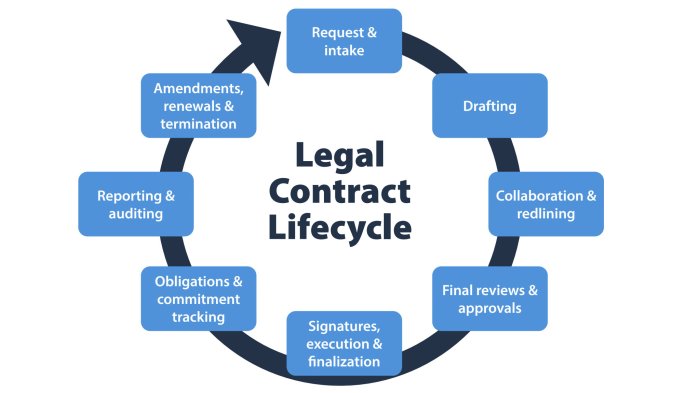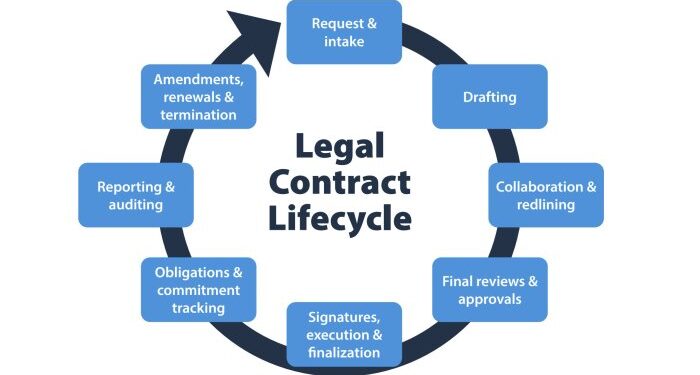Exploring the impact of Contract Lifecycle Management on legal compliance, this introduction sets the stage for a comprehensive discussion, engaging readers right from the start.
Providing insights into the key aspects of Contract Lifecycle Management and its significance in maintaining legal compliance.
Overview of Contract Lifecycle Management
Contract Lifecycle Management (CLM) is a systematic approach that organizations use to manage the entire lifecycle of their contracts, from initiation to execution to renewal or termination. In the context of legal compliance, CLM plays a crucial role in ensuring that all contracts adhere to relevant laws, regulations, and internal policies.
Stages of Contract Lifecycle Management
- Initiation: This stage involves the creation of a contract, including defining the terms and conditions.
- Negotiation: Parties involved negotiate the terms of the contract until an agreement is reached.
- Approval: Once negotiations are complete, the contract is reviewed and approved by relevant stakeholders.
- Execution: The contract is signed by all parties involved, officially making it a legally binding document.
- Compliance: Throughout the contract's lifecycle, compliance with legal requirements and internal policies must be monitored and maintained.
- Renewal/Termination: Depending on the terms of the contract, it will either be renewed for another term or terminated.
Importance of Contract Lifecycle Management in Legal Compliance
Contract Lifecycle Management is essential for legal compliance as it helps organizations ensure that their contracts meet regulatory standards, mitigate risks, and avoid legal disputes. By establishing clear processes for contract creation, negotiation, and approval, CLM helps organizations maintain transparency, consistency, and accountability in their contractual relationships, ultimately reducing the likelihood of non-compliance issues.
Benefits of Implementing Contract Lifecycle Management for Legal Compliance
Implementing Contract Lifecycle Management (CLM) can significantly boost legal compliance within an organization. By streamlining the entire contract process, CLM helps in reducing legal risks, improving efficiency, and ensuring adherence to legal requirements.
Reducing Legal Risks
- CLM centralizes all contract-related information, making it easier to track and manage legal obligations.
- Automated alerts and notifications in CLM systems help in identifying potential risks and ensuring timely action to mitigate them.
- By maintaining a complete audit trail of contract activities, CLM minimizes the chances of legal disputes and contract breaches.
Role of Automation in Improving Legal Compliance
- Automation in CLM simplifies the contract creation, negotiation, and approval processes, reducing manual errors and ensuring compliance with legal standards.
- Automated workflows help in enforcing approval hierarchies and ensuring that all necessary legal reviews are conducted before finalizing contracts.
- Integration with e-signature tools ensures legal validity and authenticity of contracts, further enhancing compliance.
Consistency in Adhering to Legal Requirements
- CLM provides standardized templates and clauses that align with legal regulations, ensuring consistency in contract terms and conditions.
- By storing all contracts in a centralized repository, CLM facilitates easy access to legal documents, enabling quick reference and compliance verification.
- Regular reporting and analysis features in CLM systems help in monitoring compliance levels and identifying areas that need improvement or corrective actions.
Ensuring Regulatory Compliance Through Contract Lifecycle Management
Contract Lifecycle Management plays a crucial role in ensuring regulatory compliance by providing a structured framework for monitoring and enforcing adherence to various laws and regulations.
Benefits of Contract Lifecycle Management in Regulatory Compliance
- Centralized Repository: Contract Lifecycle Management systems act as a centralized repository for all contracts, making it easier to track and monitor compliance with regulatory requirements.
- Automated Alerts: These systems can send automated alerts and notifications for key compliance deadlines, ensuring that necessary actions are taken on time.
- Auditing Capabilities: Contract Lifecycle Management solutions offer robust auditing capabilities, allowing organizations to conduct regular audits to ensure compliance with regulatory standards.
Examples of Regulatory Requirements Managed Effectively
- GDPR Compliance:Contract Lifecycle Management can help organizations manage data processing agreements and data protection clauses to ensure compliance with the General Data Protection Regulation.
- Anti-Bribery Laws:Companies can use Contract Lifecycle Management to monitor and enforce compliance with anti-bribery laws by including clauses prohibiting bribery in contracts.
- Health and Safety Regulations:Organizations can ensure compliance with health and safety regulations by incorporating relevant clauses in contracts and tracking adherence to safety standards.
Impact of Non-Compliance and Mitigation through Contract Lifecycle Management
Non-compliance with regulatory requirements can lead to legal penalties, reputational damage, and loss of business opportunities. Contract Lifecycle Management helps mitigate these risks by providing visibility into compliance status, facilitating timely actions to rectify non-compliance, and ensuring a documented trail of compliance efforts.
Integrating Legal Compliance Tools in Contract Lifecycle Management

Integrating legal compliance tools within Contract Lifecycle Management software is crucial for organizations to ensure adherence to regulations and mitigate legal risks effectively.
Key Features of Legal Compliance Tools
- Automated Compliance Monitoring: Legal compliance tools should have the capability to automatically monitor contract terms and conditions to ensure alignment with legal requirements.
- Alerts and Notifications: The tools should provide real-time alerts and notifications for key compliance deadlines, ensuring timely actions to maintain legal compliance.
- Document Management: Robust document management features are essential for storing and organizing legal documents, making them easily accessible for compliance audits.
- Audit Trails: Legal compliance tools should offer audit trail functionality to track changes made to contracts, enhancing transparency and accountability.
Best Practices for Enhancing Legal Compliance
- Regular Compliance Training: Conduct regular training sessions to educate employees on legal requirements and the use of compliance tools within the Contract Lifecycle Management system.
- Integration with Regulatory Databases: Integrate legal compliance tools with regulatory databases to ensure that contract terms align with the latest regulatory updates.
- Customizable Compliance Reports: Customize compliance reports to track key performance indicators and monitor legal compliance metrics effectively.
- Cross-Functional Collaboration: Foster collaboration between legal, procurement, and compliance teams to ensure a holistic approach to legal compliance management.
Outcome Summary
Wrapping up the discussion on Contract Lifecycle Management and legal compliance, this conclusion summarizes the key points discussed and leaves readers with a lasting impression.
Questions and Answers
How can Contract Lifecycle Management help in reducing legal risks?
Contract Lifecycle Management streamlines contract processes, minimizing errors and discrepancies that could lead to legal issues.
What are some examples of regulatory requirements managed effectively through Contract Lifecycle Management?
Examples include data privacy laws, industry-specific regulations, and compliance standards that can be monitored and enforced using Contract Lifecycle Management tools.
Why is automation critical in improving legal compliance through Contract Lifecycle Management?
Automation ensures consistency, reduces manual errors, and accelerates contract approval processes, all of which contribute to enhanced legal compliance.













